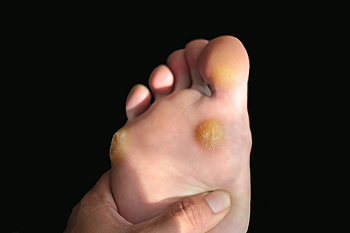 Many people will develop either a corn or callus on their foot at some point in their lives; but what are they? Corns and calluses are areas where the skin has thickened due to constant friction on the area. Corns are smaller and harder than calluses and usually develop on the toes. Calluses, meanwhile, are not usually painful compared to corns and usually occur on the bottom of the foot. Typically, either will go away if the source of friction is taken away. There are some at-home treatments that may help; however, you should consult a podiatrist first to see if they will be effective and appropriate for you. Soaking your feet can soften corns and calluses, as can moisturizers. Over-the-counter pads can help remove both but require caution in their use, as some pads contain salicylic acid—which should be avoided. Finally, one of the most important ways to prevent corns and calluses is to wear fitted and comfortable shoes that prevent friction against the area.
Many people will develop either a corn or callus on their foot at some point in their lives; but what are they? Corns and calluses are areas where the skin has thickened due to constant friction on the area. Corns are smaller and harder than calluses and usually develop on the toes. Calluses, meanwhile, are not usually painful compared to corns and usually occur on the bottom of the foot. Typically, either will go away if the source of friction is taken away. There are some at-home treatments that may help; however, you should consult a podiatrist first to see if they will be effective and appropriate for you. Soaking your feet can soften corns and calluses, as can moisturizers. Over-the-counter pads can help remove both but require caution in their use, as some pads contain salicylic acid—which should be avoided. Finally, one of the most important ways to prevent corns and calluses is to wear fitted and comfortable shoes that prevent friction against the area.
If you have any concerns regarding your feet and ankles, contact Dr. Harry I. Zirna of Lockport Foot Care, PLLC. Dr. Zirna will treat your foot and ankle needs.
Corns: What Are They? and How Do You Get Rid of Them?
Corns can be described as areas of the skin that have thickened to the point of becoming painful or irritating. They are often layers and layers of the skin that have become dry and rough, and are normally smaller than calluses.
Ways to Prevent Corns
There are many ways to get rid of painful corns such as wearing:
- Well-fitting socks
- Comfortable shoes that are not tight around your foot
- Shoes that offer support
Treating Corns
Treatment of corns involves removing the dead skin that has built up in the specific area of the foot. Consult with Dr. Zirna to determine the best treatment option for your case of corns.
If you have any questions please feel free to contact our offices located in Lockport and Medina, NY. We offer the newest diagnostic and treatment technologies for all your foot and ankle needs.
Read more about Corns: What Are They, and How Do You Get Rid of Them